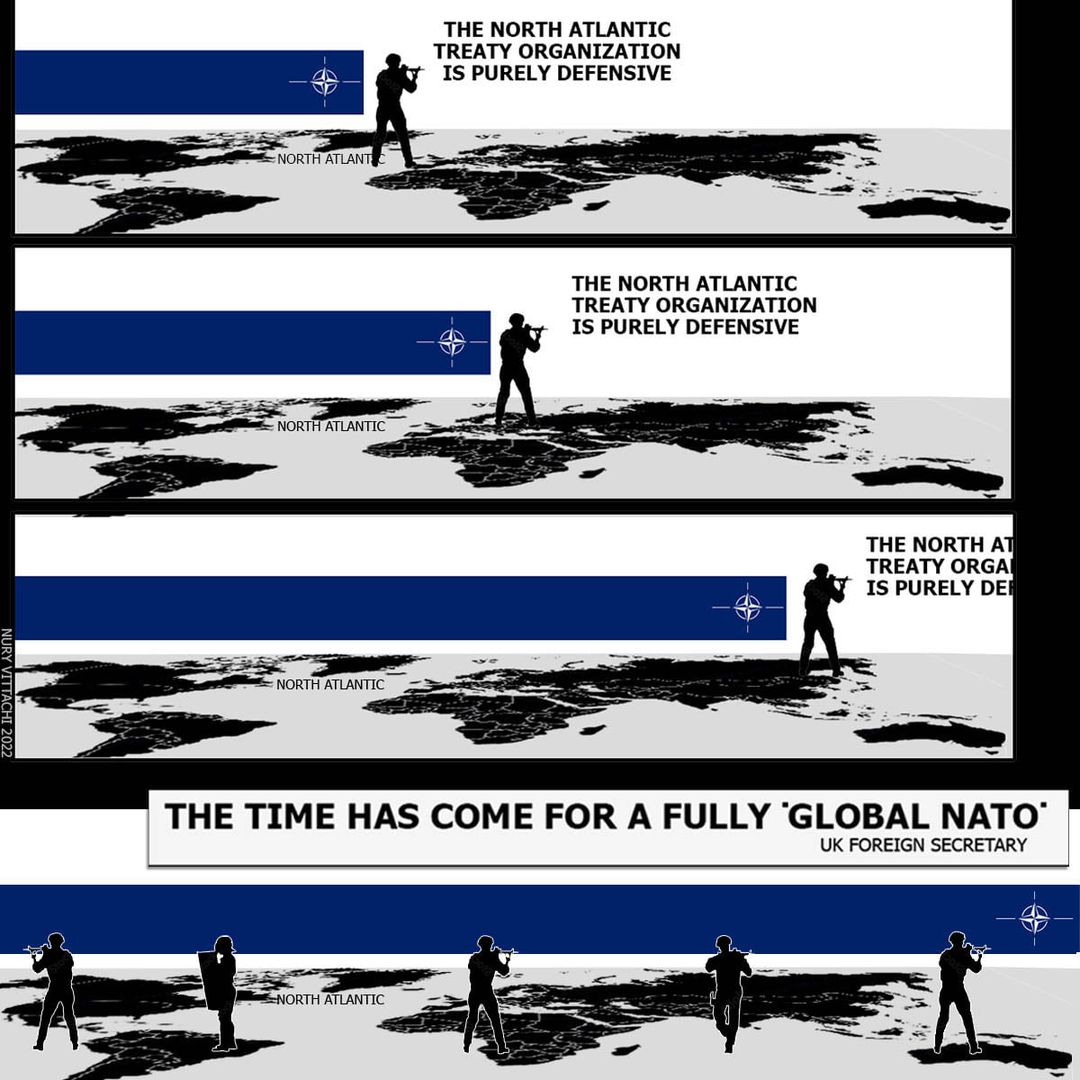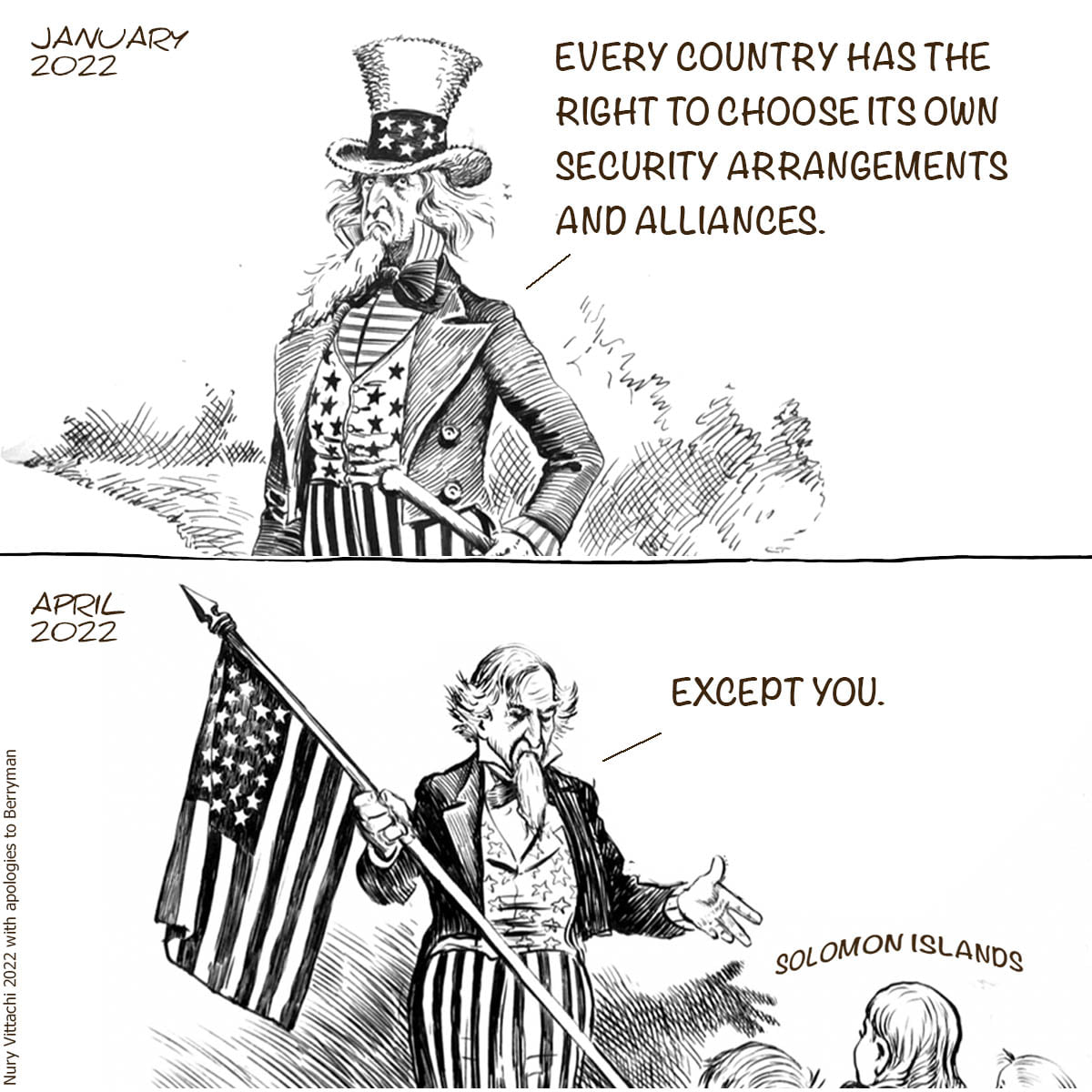PREPARATIONS FOR THE UNITED STATES to launch a war against China are far more advanced than many people realize. And when you look at just how much work has been done, it no longer looks like a matter of “if”, but more of a question of “when”.
Quietly, the United States has gone through a multi-step preparation process across numerous places in Asia, one by one.
FIRST, FRAME CHINA AS THE PROBLEM
The strategy? To start with, China is being framed as the “bad actor” challenging the “International Rules Based Order” in the narrative. It is China which is threatening the stability of the region, according to repeated allegations. The U.S., in contrast, is the heroic savior from far away, militarizing Asia to bring peace and safety to the region through what they refer to as “an integrated deterrence strategy”.
This framing serves several purposes.
First, and most importantly, it builds consensus among the west’s allies to work to gather the unwavering support of the people they claim to represent.
Second, by establishing China’s bad-guy positioning early, it makes the timing flexible. It is abundantly clear by now that this “Shaping of the Theater” in respect of Taiwan is very advanced; almost as advanced as the shaping of the Ukraine theater for war with Russia was in 2021.
Third, it provides material so that the war can be provoked into being, and the victim blamed; China will be presented as wholly responsible for any and all conflicts that break out.

COULD CONFLICT REALLY HAPPEN?
But is a war really possible? It would be a big step, but the possibility is very real. It is worth remembering the vacillation of many people around the world about the tensions around Ukraine in 2020.
Many people were skeptical that real fighting would happen—including Ukraine President Volodymyr Zelenskiy. People assumed that the various parties were just posturing. And yet, here we are, one and half years into a very real conflict.
The Ukraine conflict was flagged well in advance of fighting breaking out – and the same can be said of the Taiwan situation.
CREATING PACTS
The preparations for war have taken several steps forward with quiet changes in pacts and agreements. This started in June 2022 with the modification to Article 5 of NATO’s mutual defense pact, which says that an attack on one is an attack on all.
This forces others to fight with, or on behalf of, the United States.

The geographical remit of NATO has been quietly expanded to include the Indo-Pacific region. NATO increased their “Major Non-NATO Allies” membership list to include Ukraine, South Korea, and others. This includes the Chinese territory of Taiwan, under the auspices of the Taiwan Relations Act. This is yet to be signed, awaiting final passage at an optimal time of the U.S. administrations choosing.
In short, it is undeniable that the United States has spent several years, at least since 2016, carefully preparing for conflict in Asia. They have been insidiously shaping the theater for war on multiple levels. It will be a hybrid, multi-domain, full spectrum effort when ultimately ready for launch.

When will it start? It is inching closer with each passing month and week. There have been many deliberate acts of escalating provocation over recent years.
TURNING AUSTRALIA INTO A PARTNER
The U.S. shaping of the theater for war in Asia has been a gradual strategy using a hub and spoke approach.
Take Australia. The AUKUS defense agreement was signed between Australia, the United Kingdom, and the United States in 2022. But with a decades-long development program, the weapons that will ultimately come into being were clearly not intended for near-term use. No; AUKUS has been about turning Australia into a spoke in the hub—a partner who cannot say no.

The AUKUS pact was designed to close gaps in existing defense agreements, and pacts between western allies, and also to lower the bar for compelling the signatories of said pacts and agreements to participate actively in a potential war.
It doesn’t matter if the nuclear-powered subs won’t be ready for many years – look, the U.S. can say, Australia is already a partner who has to fight in our wars; they signed up for this.

USE OF THE PHILIPPINES
The announcement earlier this year of additional access to bases in the Philippines by the U.S. is also part of the hub and spoke shaping.
That story really began in 2016 with the revised posture of the U.S. Marine Core. It made a doctrinal switch, abandoning heavy armour and artillery in favour of more nimble and versatile mobile missile batteries. The transitional period for such a doctrinal change at that level of operational unit usually lies between six and seven years. Bases relatively near China are needed.
Before, the U.S. had five operational bases in the Philippines. That number has now grown to nine, according to reports.
But is it really nine in total? The National Security Secretary of the Philippines challenged the base expansion; however, interestingly, she did not simply refer to four new bases. She instead referred to the implementation of “21 projects”, questioning the risks presented.
This correlates to the suggestion that the new bases are likely intended as Forward Operating Bases with satellite bases connected to them, to service the deployment of scores of mobile missile units and their force protection personnel.

As recently as last week, Japan and the Philippines acknowledged they are close to signing a defense pact in the form of a Visiting Forces Agreement, which will incidentally accelerate another emergent trilateral alliance between Japan, Philippines and the U.S. And, yes, of course it has the mandatory ugly acronym: JAPHUS.
Therefore, the integration of the Philippines as a major hub in the U.S. strategy is almost complete.
CAMP DAVID SUMMIT
Then of course there are the U.S.’s traditional outplacements in Asia. President Joe Biden hosted a trilateral summit in Camp David on the 18th of August 2023 between the U.S., Japan, and South Korea.
It was lauded by the U.S. (and echoed by Western mainstream media) as a necessary and timely display of unity by the West and their Asian allies as a means to contain and counter the rise of China, which they portray as a source of conflict with other nations. (Projection, much?)
They alleged that China has predatory hegemonic and aggressive designs on its neighbours and beyond, and presented a clear and present danger to the much trumpeted international “Rules-Based Order” ordained by the platinum club of rich Western nations.
(We shall not even get into the stunning hypocrisy of the hysterical coverage by the media of similarly designed defense and security alignments between nation states such as China and Russia, or other non-platinum club nations.)

ALLIES ARE HUBS
The recent Camp David trilateral meeting is not merely just another spoke in the hub development, drawing Asia ever closer into the divisive strategy of the United States and its much sought-after Cold War 2.0.
It is a very dangerous next step, escalating already dangerously high tensions between Asian neighbors.
Japan and South Korea are critical hubs in this U.S. strategy. Their defense pacts and agreements with the U.S., Australia, Philippines, U.K. and between other nations are the spokes. The inclusion of agreements regarding assurances for the defense of Taiwan are designed explicitly to be interlocking.
RAISING TENSIONS
These interlocking defense pacts and agreements, layered upon each other, are spreading like tentacles across the region.
They are exacerbating problems with already fragile fault lines and raising tensions to a dangerous level.
Which is exactly what they are intended to do.
The irony, of course, is that the media warnings about a dangerous superpower poised to cause enormous harm in Asia, is absolutely true.
But that superpower is not China.
Phill Hynes is a specialist in Asian geopolitics based in Hong Kong.
Image at the top by Pexels.
E
